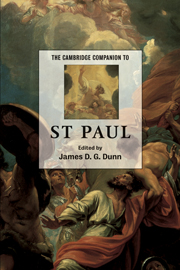Book contents
- Frontmatter
- Introduction
- Part I Paul’s life and work
- Part II Paul’s letters
- 3 1 and 2 Thessalonians
- 4 Galatians
- 5 1 and 2 Corinthians
- 6 Romans
- 7 Philippians
- 8 Colossians and Philemon
- 9 Ephesians
- 10 The Pastoral Epistles
- Part III Paul’s theology
- Part IV St Paul
- Select bibliography
- Index of References
- General Index
7 - Philippians
from Part II - Paul’s letters
Published online by Cambridge University Press: 28 May 2006
- Frontmatter
- Introduction
- Part I Paul’s life and work
- Part II Paul’s letters
- 3 1 and 2 Thessalonians
- 4 Galatians
- 5 1 and 2 Corinthians
- 6 Romans
- 7 Philippians
- 8 Colossians and Philemon
- 9 Ephesians
- 10 The Pastoral Epistles
- Part III Paul’s theology
- Part IV St Paul
- Select bibliography
- Index of References
- General Index
Summary
Written to a Christian community with whom Paul has had a long and happy relationship, the letter to the Philippians is characterized by joy - a remarkable fact, since it was sent from prison, where its author was held on a capital charge. The letter expresses confidence about Paul's own future since, whether he lives or dies, Christ is with him (1:19-26), and about the Philippians, whom he describes as his joy and his crown (4:1), concerning whom he will boast on the day of judgment (2:16).
CONTEXT
Paul’s authorship of this letter has rarely been doubted. It was written to Christians in Philippi, a fairly small city of about 10,000 inhabitants in eastern Macedonia. In the first century ad, Philippi was important as an agricultural centre; it was a Roman colony, which meant that its citizens enjoyed considerable legal and property rights, and the city’s administration was modelled on that of Rome. Communications were reasonably easy by the standards of that time, since the city was conveniently placed on the Via Egnatia, along which one could travel westwards to the Adriatic coast, while the port of Neapolis lay ten miles to the south.
- Type
- Chapter
- Information
- The Cambridge Companion to St Paul , pp. 105 - 115Publisher: Cambridge University PressPrint publication year: 2003



